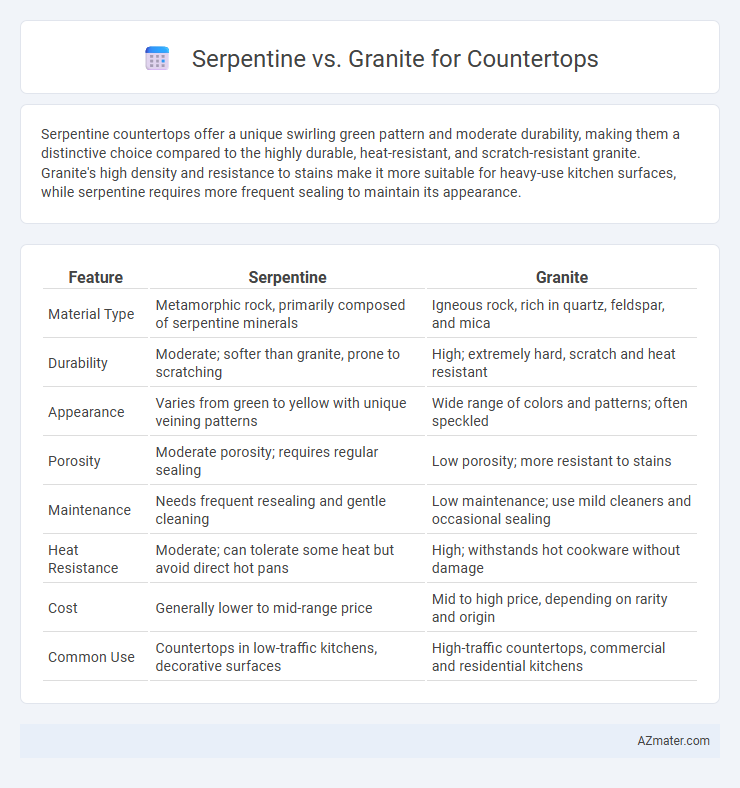Serpentine countertops offer a unique swirling green pattern and moderate durability, making them a distinctive choice compared to the highly durable, heat-resistant, and scratch-resistant granite. Granite's high density and resistance to stains make it more suitable for heavy-use kitchen surfaces, while serpentine requires more frequent sealing to maintain its appearance.
Table of Comparison
| Feature | Serpentine | Granite |
|---|---|---|
| Material Type | Metamorphic rock, primarily composed of serpentine minerals | Igneous rock, rich in quartz, feldspar, and mica |
| Durability | Moderate; softer than granite, prone to scratching | High; extremely hard, scratch and heat resistant |
| Appearance | Varies from green to yellow with unique veining patterns | Wide range of colors and patterns; often speckled |
| Porosity | Moderate porosity; requires regular sealing | Low porosity; more resistant to stains |
| Maintenance | Needs frequent resealing and gentle cleaning | Low maintenance; use mild cleaners and occasional sealing |
| Heat Resistance | Moderate; can tolerate some heat but avoid direct hot pans | High; withstands hot cookware without damage |
| Cost | Generally lower to mid-range price | Mid to high price, depending on rarity and origin |
| Common Use | Countertops in low-traffic kitchens, decorative surfaces | High-traffic countertops, commercial and residential kitchens |
Introduction to Serpentine and Granite Countertops
Serpentine countertops offer a unique aesthetic with their rich green hues and smooth, polished surface, derived from the metamorphic rock serpentine, known for its durability and resistance to heat. Granite countertops, composed of interlocking crystals of quartz, feldspar, and mica, are favored for their hardness, scratch resistance, and wide range of color variations. Both materials provide distinct visual appeal and functional benefits, making them popular choices for kitchen and bathroom surfaces.
Origins and Composition: Serpentine vs Granite
Serpentine countertops originate from metamorphic rocks rich in magnesium and iron silicate minerals, often characterized by their smooth, pearly luster and green shades. Granite forms from the slow crystallization of magma beneath Earth's surface, composed primarily of quartz, feldspar, and mica, which gives it durability and a speckled appearance. The key distinction lies in Serpentine's softer, more malleable composition compared to Granite's coarse-grained, highly durable texture ideal for heavy-use surfaces.
Appearance and Color Variations
Serpentine countertops offer a unique, swirling pattern with rich green hues ranging from deep olive to vibrant emerald, often featuring subtle veins of white or gold that create a warm, organic look. Granite countertops display a broad spectrum of color variations, from classic black and gray to pink, red, and even blue tones, with speckled or veined patterns that add depth and texture. While serpentine provides a softer, more uniform appearance, granite's diverse colors and patterns make it a versatile choice for bold or traditional kitchen designs.
Durability and Hardness Comparison
Granite countertops rank high in durability and hardness due to their natural composition of quartz, feldspar, and mica, making them resistant to scratches, heat, and stains. Serpentine, while visually appealing with its unique veining, tends to be softer and less durable, leading to easier scratching and wear over time. Homeowners seeking long-lasting, hard-wearing surfaces often prefer granite for its superior resistance to everyday kitchen impacts and abrasions.
Maintenance and Care Requirements
Serpentine countertops demand careful maintenance due to their relative softness and susceptibility to scratches and etching, requiring regular sealing to protect against stains and moisture damage. Granite is more durable and less porous, making it resistant to scratches and heat, but it still needs periodic sealing to prevent stains and maintain its natural shine. Both materials benefit from gentle cleaning with pH-balanced cleaners and avoiding harsh chemicals to preserve their surface integrity and longevity.
Heat and Stain Resistance
Serpentine countertops offer moderate heat resistance but are more porous, making them less stain-resistant compared to granite. Granite is highly heat-resistant, tolerating hot pots and pans without damage, and its dense structure provides superior stain resistance. For kitchens requiring durable surfaces that withstand heat and resist staining, granite is generally the preferred choice over serpentine.
Cost and Affordability
Serpentine countertops typically cost between $30 to $60 per square foot, making them a more affordable option compared to granite, which ranges from $40 to $100 per square foot depending on quality and origin. The lower price of serpentine is due to its relative abundance and ease of extraction, while granite's higher cost reflects its durability and the complexity of quarrying. Choosing serpentine can provide cost savings without sacrificing aesthetic appeal, especially for budget-conscious kitchen remodels.
Environmental Impact and Sustainability
Serpentine countertops have a lower environmental impact due to their natural abundance and minimal processing requirements compared to granite, which often involves intensive quarrying and energy usage. Serpentine's softer composition allows for reduced carbon emissions during fabrication, while granite extraction contributes to habitat disruption and higher waste generation. Choosing serpentine supports sustainability by promoting the use of eco-friendlier materials with a smaller carbon footprint and less ecological disturbance.
Pros and Cons of Serpentine Countertops
Serpentine countertops offer unique aesthetic appeal with their rich green hues and swirling patterns, providing a distinctive natural stone option that can elevate kitchen and bathroom designs. They are heat-resistant and relatively durable but tend to be softer and more prone to scratches and etching compared to granite, requiring regular sealing and careful maintenance to preserve their surface. While serpentine is generally more affordable than high-end granite varieties, its susceptibility to damage and need for upkeep may influence long-term cost-effectiveness and durability considerations.
Pros and Cons of Granite Countertops
Granite countertops offer exceptional durability, resistance to heat, and scratch-proof qualities, making them ideal for high-traffic kitchens. They require periodic sealing to prevent staining and can be relatively expensive compared to other materials. The unique, natural patterns and color variations of granite enhance aesthetic appeal and increase home resale value.

Infographic: Serpentine vs Granite for Countertop
 azmater.com
azmater.com